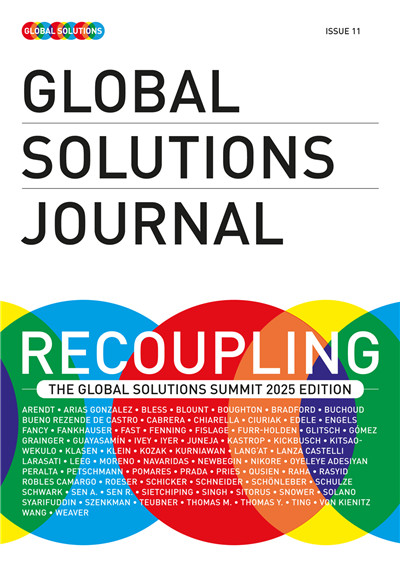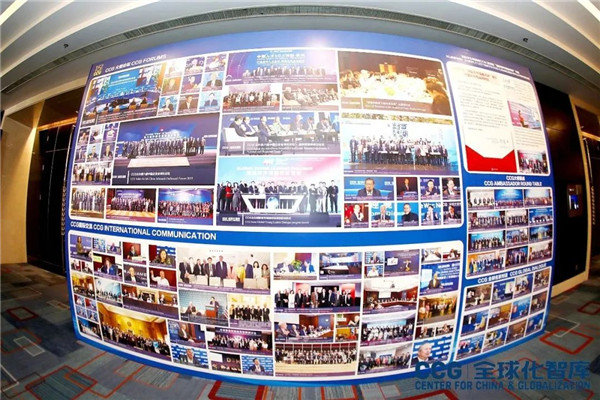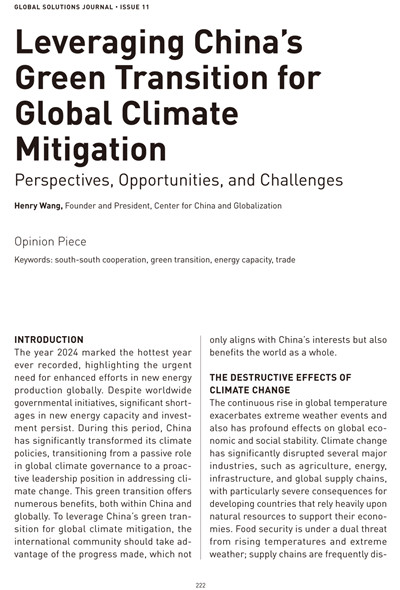Wang Huiyao: Leveraging China’s green transition for global climate mitigation
May 07 , 2025Leveraging China’s green transition for global climate mitigation: perspectives, opportunities and challenges
By Wang Huiyao | Founder of the Center for China and Globalization(CCG)
The year 2024 marked the hottest year ever recorded, highlighting the urgent need for enhanced efforts in new energy production globally. Despite worldwide governmental initiatives, significant shortages in new energy capacity and investment persist. During this period, China has significantly transformed its climate policies, transitioning from a passive role in global climate governance to a proactive leadership position in addressing climate change. This green transition offers numerous benefits both within China and globally. To leverage China’s green transition for global climate mitigation, the international community should take advantage of the progress made, which not only aligns with China’s interests but also benefits the world as a whole.
The Destructive Effects of Climate Change
The continuous rise in global temperature exacerbates extreme weather events and also has profound effects on global economic and social stability. Climate change has significantly disrupted several major industries such as agriculture, energy, infrastructure, and global supply chains, with particularly severe consequences for developing countries that rely heavily upon natural resources to support their economies. Food security is under a dual threat from rising temperatures and extreme weather; supply chains are frequently disrupted, and infrastructure is damaged, further fuelling the precarious state of the global economy.
Severe Shortages in New Energy Capacity and Investment
Despite worldwide governmental initiatives, significant shortages in new energy capacity and investment persist. The International Energy Agency ( IEA) calls for an annual investment of $4.5 trillion in green energy. However, in 2023, only a fraction of the proposed amount was spent -a mere $1.3trillion. This large gap between demand and actual progress highlights the urgency and necessity to develop cost-effective products, improve on resource allocation to increase efficiency, and advancement in technology to accelerate progress. Solar panels present immense growth potential to be a key player in combating global climate change, with the IEA forecasting that global demand for new photovoltaic installations will reach 820 gigawatts. Yet again, in 2022, production capacity was still insufficient, meeting only one-quarter of that target–far from overcapacity. Similarly, the electric vehicle (EV) market grew exponentially in 2023, with global EV sales rising by 35% year-on-year. However, while global demand for EVs is projected to reach 30 million units by 2027, China exported only 1.2 million EVs in 2023, underscoring a severe supply shortage.
This shortage primarily affects developing countries, whose transition to a low-carbon economy and fight against climate change challenges urgently require funding and technological support from the international community. Therefore, countries should commit to promoting the usage and flow of green technology and green products through an open and inclusive international trading system and avoid politicization of climate issues or their use as economic tools. Any policies that hinder the global transition to a green economy, excessive trade restrictions in particular, will complicate global climate cooperation and weaken the collective power and response to climate change.
China’s Progress Towards a Green Transition
In recent years, China’s climate policies have undergone a significant transformation, shifting from passive participation in global climate governance to taking on a responsible leadership role in combating climate change. President Xi Jinping launched the Global Development Initiative at the United Nations General Assembly, emphasizing the need to accelerate the transition to a green, low-carbon economy and achieve green recovery and development, while also improving global environmental governance to actively respond to climate change.
China has not only committed to achieving carbon peak by 2030 and carbon neutrality by 2060 but also is advancing international green development cooperation through mechanisms such as the Belt and Road Initiative (BRI). By actively participating in international climate agreements and promoting sustainable trade, China is gradually coming to the forefront of global climate governance. Former Vice Minister of Commerce and former WTO Deputy Director-General Yi Xiaozhun recently highlighted at a seminar at WTO headquarters that China’s green policies not only have profound impacts on its domestic economy but also provide significant momentum for the Global green transition.
Currently, although coal remains China’s dominant energy source, the country is actively reducing its reliance on coal by significantly expanding renewable energy and nuclear power. According to China’s 14th Five-Year Plan (2021-2025), the total installed capacity of renewable energy, such as wind and solar power, is expected to exceed 1.2 billion kilowatts by 2030. Clean energy will become a core component of China’s future energy structure.
Also, China has invested heavily in advancing renewable energy technologies, EV technologies, smart grids, energy storage systems, and other environmentally friendly technologies. Additionally, China is implementing a nationwide carbon trading market. This system aims to use market mechanisms to incentivize businesses to reduce their carbon emissions and drive high-emissions industries to accelerate technological upgrades and transition to greener practices. Furthermore, China is actively promoting the development of “new infrastructure,” including 5G, artificial intelligence, and the Internet of Things, which, through widespread application, will improve energy efficiency and reduce the carbon footprint.
China’s Green Transition is Becoming More Market-Driven than Government-Led
As Yi Xiaozhun emphasized, the green transition is driven more by market competition and technological innovation rather than relying on government subsidies. He noted that the success of China’s renewable energy industry is not based on long-term government subsidies but rather more about fostering market competition, rapid technological innovation, and its super large market scale.
In the process of developing a green economy, China has established a national carbon emissions trading market, creating a market-based mechanism for emissions reduction to ensure transparency and fairness in carbon trading. It not only helps China control its total carbon emissions but also safeguards fair competition in international trade, providing a more equitable environment for Chinese enterprises to engage in global markets. Through these measures, China promotes its green economic transition while also upholding the stability of the multilateral trading system, demonstrating its commitment to international sustainable development.
Government subsidies helped China’s renewable energy industry achieve rapid growth at the early stages. However, in recent years, China has gradually reduced subsidies in sectors such as photovoltaics, wind power, and EVs. For instance, the “Notice on Matters Relevant to Photovoltaic Power Generation in 2018” significantly reduced photovoltaic subsidies and limited the scale of new photovoltaics projects. As these subsidies decreased, Chinese photovoltaics companies improved their competitiveness by enhancing technology and reducing production costs, gradually lowering the price of electricity. This transition has enabled them to secure a dominant position in the global market.
In the EV sector, the Chinese government’s subsidies began to gradually decrease in 2017 and the subsidies for EV buyers were completely cancelled in 2022. The withdrawal of these subsidies accelerated the marketization of the industry, pushing EV companies to compete through technological innovation and cost control. In 2018, China had as many as 480 EV manufacturers, but due to intense market competition, only about 50 companies remain today. This competitive pressure has driven companies to continuously improve their technology and reduce production costs, allowing them to secure a more advantageous position in the international market.
China is Facing Growing Criticism Over Overcapacity and Tariffs
This green transition offers numerous benefits both within China and globally, including lower energy costs, environmental protection, and support for other nations through trade and technology transfer. However, China’s efforts face criticism over potential overcapacity and challenges from tariffs and protectionist measures. In recent years, due to the combined effects of geopolitical tensions, rising economic protectionism, and the COVID-19 pandemic, the trend of deglobalization has intensified. This has led to profound changes in the global trade landscape, particularly in renewable energy and green technology, where heightened competition among countries has exacerbated the instability and unsustainability crisis of the global trading system.
Global trade growth has been one of the key drivers of economic growth and technological advancement. However, with the rise of trade protectionism, particularly the “local-first” policies adopted by major economies in recent years, the openness and fairness of international trade have faced unprecedented challenges. In response to competition in renewable energy products, countries have implemented measures that conflict with free trade policies, such as tariffs and other green barriers. These policies have not only sparked widespread controversy globally but also intensified conflicts in international efforts to address climate change and coordinate trade policies.
Recommendations for China and the Global Green Transition
In the context of addressing climate change and achieving sustainable development, international trade policies are gradually transitioning toward green and low-carbon models. Rather than resorting to protectionism, the focus should be on fostering cooperation among all stakeholders. Governments, businesses, and international organizations should work together to develop and implement sustainable trade policies, promoting the global circulation of green products and technologies to achieve a win-win situation for economic growth and environmental protection. Below are the recommended measures:
Formulate Sustainable Trade Policies and Optimize the Structure of Green Products
Sovereign nations should develop trade policies from the perspective of sustainable development, encouraging the export of sustainable products while restricting the export of raw materials with high energy consumption and high emissions. This will help optimize the global structure of green products and services trade.
By leveraging regional industrial advantages and strengths in green development, countries should accelerate the transformation towards green energy, promote the application of green technologies, and encourage businesses to prioritize low-carbon, energy-efficient, environmentally friendly, and green materials and technologies in their design and manufacturing. This will enhance the competitiveness of green product exports.
For example, the automotive sector in China and Europe could pioneer new forms of industrial collaboration through joint research and development facilities, shared talent development programmes and harmonised technical standards. Chinese manufacturers could establish production bases in Europe, creating jobs and fostering technological exchange. Currently, BYD is establishing a battery production facility in Hungary, adding to the region’s EV manufacturing capacity, while CATL, a global leader in battery technology, is developing multiple major projects across Germany, Hungary and Spain. These investments show how manufacturing synergies can move in both directions, following the successful model of European carmakers in China but adapted for today’s evolving automotive landscape. The EU and China should also revive negotiations on the Comprehensive Agreement on Investment, which would provide crucial institutional safeguards for businesses.
Deepen Multilateral, Bilateral, and Regional Cooperation
Countries should collectively uphold the international system with the United Nations at its core, and work towards the full implementation of the United Nations Framework Convention on Climate Change (UNFCCC) and the Paris Agreement. Countries should actively advocate for sustainable investment, production, and consumption in the UN Sustainable Development Goals (SDGs) policy framework. The WTO, as a platform, can be leveraged to foster global governance consensus, update rules, and promote the establishment of a new sustainable trade mechanism. Countries should also promote policies that encourage sustainable trade, use multilateral negotiations to reduce or even exempt tariffs on sustainable products, and offer trade facilitation measures for their customs clearance.
Advancing Low-Carbon Regulations and Strengthening International Cooperation
Countries should strengthen international cooperation and advance low-carbon regulations within major global institutions. In 2012, APEC members reached the world’s first substantive agreement on a list of environmental products aimed at promoting trade liberalization in such products, covering 54 customs tariff codes. In 2021, the IMF recommended that the world’s major carbon-emitting countries increase carbon prices under the G20 framework in consideration of development stages and historical emissions responsibilities, and establish a carbon price floor. The OECD has long emphasized the importance of carbon pricing, identifying it as the most crucial policy tool to address climate change. Countries should effectively leverage existing multilateral collaboration platforms to promote policy coordination in sustainable trade and green finance, setting unified standards under an inclusive framework. Additionally, efforts should be made to enhance supply chain transparency and foster technological innovation cooperation.
Strengthening International Cooperation in Green Industrial Chains
China should drive low-carbon development in upstream and downstream industries, as well as related sectors. International cooperation in green manufacturing should also be strengthened to promote the establishment of a cooperation system for green, low-carbon industrial and supply chains, ensuring the efficient integration of high-end resources with the real economy. Other measures include enhancing technical exchanges and cooperation, reducing the market entry costs for green products and technologies to accelerate their global adoption, and improving the top-down design for addressing climate change.
Deepening International Cooperation in Green Finance
China should promote practical cooperation in climate investment and financing, such as encouraging the development of green credit, green bonds, green insurance, and other financial products can provide financing support for energy conservation, environmental protection, clean production, clean energy, ecological environment, green infrastructure, green services, and other key areas. China should also improve mechanisms for international cooperation in green finance by enhancing alignment in assessment standards, environmental and governance information reporting, and disclosure, in addition to actively exploring and developing international green finance standards and strengthening global coordination within a standard green finance framework. It is recommended that China’s multilateral banks such as the Asian Infrastructure Investment Bank (AIIB) and the New Development Bank (NDB) provide credit services, issue sustainable bonds, invest in carbon reduction initiatives and green economies in developing countries, and help underdeveloped economies establish carbon markets.
Promoting South-South Cooperation for Joint Green Transition
China is recommended to enhance South-South cooperation in green transition. In November 2023, China signed 48 South-South cooperation agreements on climate change with BRI partner countries. Designing and promoting green transition plans within economic and trade cooperation zones along the BRI route is recommended to help address the needs of BRI countries in transforming traditional industries and upgrading energy infrastructure. China can increase the export of green technologies and green production capacities, using its experience to expand green transition with BRI countries.
In conclusion, addressing climate change calls for immediate and sustained global action. The international community must unite, building on the current momentum to strengthen collaboration in the green transition and climate solutions. Through collective effort, we can shape a future where climate action is not only a necessity but also a catalyst for global progress, innovation, and shared prosperity.
From GLOBAL SOLUTIONS JOURNAL ISSUE 11, 2025-5-7

Topical News See more







